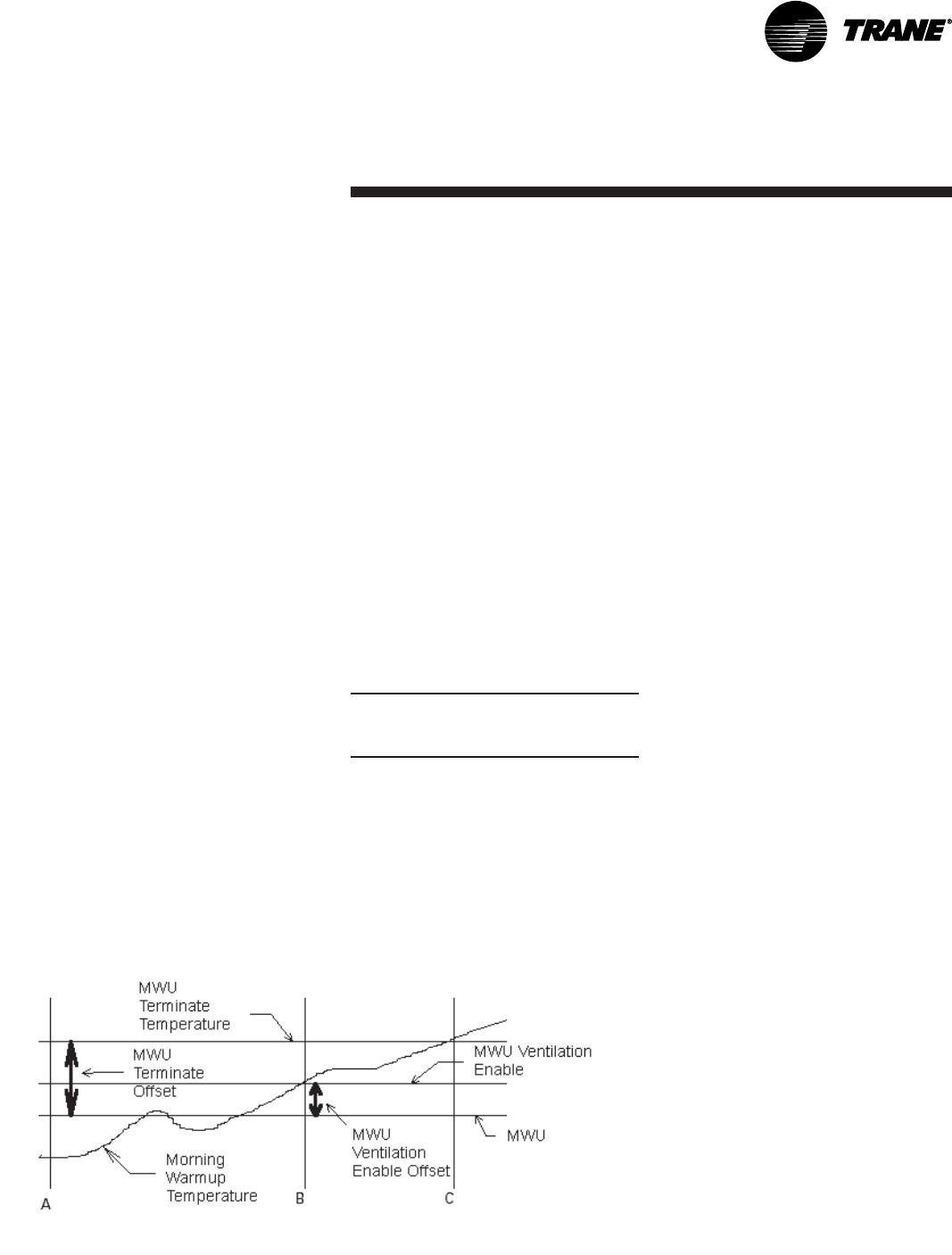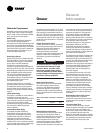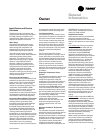
SCXG-SVX01B-EN 91
Owner
Control Sequences of
Operation
Occupied/Unoccupied Switching
There are four ways to switch occupied/
unoccupied:
(1) Night setback zone sensor
(2) Field-supplied contact closure
(hardwired binary input to RTM)
(3) Tracer Summit
®
(4) Factory-mounted time clock
Field Supplied Occupied/Unoccupied
Input on the RTM
This input accepts a field supplied switch
or contacts closure, such as a time clock,
with a rating of 12 mA at 24 VDC
minimum.
Tracer Summit
®
System
The Tracer Summit
®
system can control
the occupied/unoccupied status of the
self-contained unit.
Factory Mounted Time Clock
A time clock can control the
occupied/unoccupied status of the
self-contained unit.
Unoccupied
The unoccupied mode helps conserve
energy during times when a building is
usually unoccupied. When in unoccupied
mode, the unit will control to the
unoccupied setpoints (usually a lower
heating setpoint and higher cooling
setpoint). Setpoints can be programmed
at the HI, Tracer Summit
®
, or the night
setback zone sensor.
The unit enters the unoccupied mode
when the RTM receives a closed signal
Figure O-SO-1. Typical cycling morning warmup cycle.
temperature is below the MWU setpoint,
the unit enters the MWU mode.
Morning Warmup
This feature can be enabled at the HI, and
can be used with factory or field-installed
heat. If MWU is not required disable the
function in the setup menu at the HI.
MWU transitions the zone from
unoccupied to occupied. It will heat until
the MWU setpoint is met. The unit is then
released to occupied mode. Supply duct
static pressure is maintained during this
sequence. MWU can be set (at the HI) to
function as either full or cycling capacity.
Full Capacity Morning Warmup (MWU)
Full capacity morning warmup uses full
heating capacity to heat the zone as
quickly as possible. Full heating capacity
is provided until the morning warmup
setpoint is met. At this point, the unit is
released to daytime mode.
Cycling Capacity Morning Warmup
(MWU)
Cycling capacity morning warmup
provides a more gradual heating to
overcome “building sink” as the zone is
heated. Normal zone temperature control
with varying capacity is used to raise the
zone temperature to the MWU zone
temperature setpoint. This method of
warmup is used to overcome the
“building sink” effect.
Reference Figure O-SO-1 for a pictorial
explanation of the cycling MWU se-
quence. Cycling capacity MWU will heat
until MWU temperature setpoint is
reached. Next a 60 minute timer begins. If
the building load reaches the MWU
ventilation setpoint, or the 60 minutes
expire, whichever is first, the airside
economizer will control to the minimum
position. MWU will end when the zone
temperature rises above the MWU
terminate setpoint.
Sequence of
Operation
on the unoccupied input for more than
five seconds.
For units with supply air temperature
control entering the unoccupied mode,
the following sequence will occur:
• Heating/cooling functions cease and the
economizer option closes fully. The
supply fan shuts down for proper cool-
down time of the heat exchanger.
However, the supply fan may remain
on for a short period of time.
• After the supply fan shuts down, the
occupied/unoccupied relay energizes
and the IGV option fully opens. Also, the
VAV box stroke time begins. The VAV
box stroke time is field adjustable to
allow time for VAV boxes to go to the
full open airflow position.
• After the max VAV box stroke time
expires and the IGVs are fully open, the
supply fan, economizer (if enabled),
compressors, and heat enable to satisfy
the unoccupied zone temperature
setpoints.
Note: Unoccupied economizer operation
can be enabled or disabled at the HI or
using Tracer Summit
®
.
For units without volume control entering
the unoccupied mode, the following
sequence will occur:
• The occupied/unoccupied relay
energizes and the economizer option
fully closes.
• The fan mode is set to auto and the unit
will control to the unoccupied zone
temperature setpoints.
With MWU enabled at the HI, if the zone


















